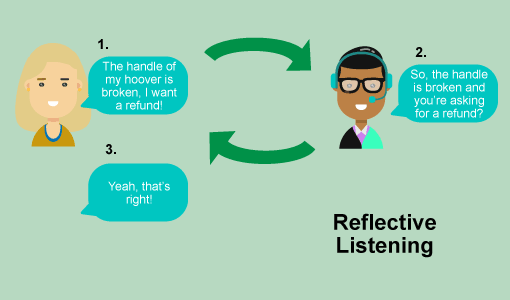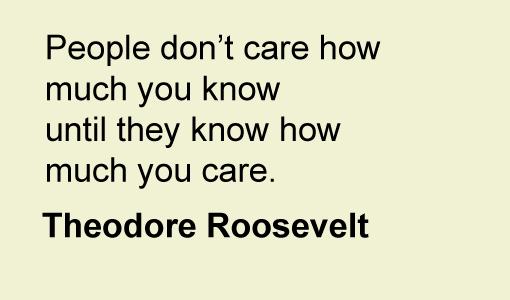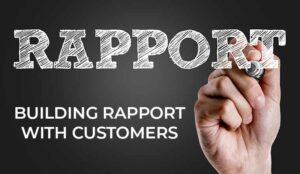Struggling to connect with customers on your calls? You’re not alone – building genuine rapport over the phone can be challenging, but it’s one of the most important skills a contact centre advisor can develop.
When done right, it transforms conversations, improves outcomes, and makes interactions more enjoyable for both sides.
In this article, we share ways help advisors build rapport over the phone and create more meaningful customer connections.
Are You Having a Difficult Time Establishing Rapport on Your Calls?
Rapport building is an integral part of the communication process. Lack, or absence, of rapport can fundamentally affect the outcome of any conversation.
When you build rapport, the conversation runs smoothly, it is enjoyable and the results are so much better than when the communication is strained and advisors fail to ‘gel’ with the person they are talking to.
Good rapport isn’t about ‘making best friends’ with the caller. It means creating a comfortable ‘state’ where all parties converse freely and comfortably. The extra benefit is that it makes the time spent with the caller more enjoyable for the advisor.
So, it’s important for advisors to know a few simple techniques to help them build rapport over the phone, while contact centre managers can also do their bit to make this process easier.
How Can Contact Centre Advisors Build Rapport?
Building rapport is important – but how can advisors actually do it on live calls? Here are some practical tips to help them create stronger connections and more positive customer experiences.
1. Open the Call With a Smile
Believe it or not, a smile can be heard in your voice, and a ‘smiling tone’ instantly makes you sound more welcoming and relaxed. Your caller may not realise it, but they’ll subconsciously feel more comfortable and respond more positively to you.
One of Call Centre Helper’s readers, Kevin, found that “indeed it does work. We have done practice sessions where two advisors sit back to back and one of them talks and the other listens.
They can normally hear if the advisor is smiling, as well as things like posture. It also comes across if someone is grumpy and slouching.
In fact, if you try to put on a positive tone without smiling it’s very difficult. I suppose that is where the cheesy phrase ‘Smile and Dial’ comes from.”
Watch this video, where Christine Knott explores the importance of smiling on calls with customers:
2. Start the Conversation With a “Warm Up”
Start the conversation with a simple question that will let your caller know you are human! This could be ‘how is your day so far?’ or ‘how is the weather where you are today? Better than here, I hope!’
Most people will respond to you in a friendly manner and it helps to relax you and your caller by breaking the ice.
Reply to their answer with a relevant but positive response and then move the call forward, for example, you could say:
- “That’s great, I’m glad you are having a good day. How can I help with your call today?”
- “So the weather is as bad as it is here. Never mind, the sun could be out tomorrow for us. How can I help with your call today?”
3. Listen Well
Advisors are often told to employ active listening, where they are basically instructed to avoid distractions and allow themselves to concentrate on your caller and their conversation.
This is important, but you could even take this one step further and use reflective listening. This is where you try to understand the customer’s points and then repeat them back, to ensure that everything has been fully understood.
By doing so, you are demonstrating to the customer that you are mentally engaged in the process, while you can do your bit to ensure mutual understanding.

If you want ways to help train active listening in your agents, read our article: How to Train Active Listening in the Call Centre – With Exercises
4. Let the Caller Know You Are Listening
Let the caller know you are listening by responding with gentle and soft ‘ums’ and ‘ahs’ as they speak. These are also known as “verbal nods”.
Allow the speaker to finish what they are saying – practise this with every call. If you interrupt, your caller could become frustrated. No matter how many techniques you are taught to use on the phone, common courtesy will always be essential.
5. Use Words That Your Caller Uses
Use words that your caller uses in their conversation, especially any adjectives – the words they use to describe something. They have chosen to use these words, so they have a relevance to the content; an alternative word may not have the same meaning for them.
For example, if your caller says: “the results were excellent”, the word ‘excellent’ was chosen because it reflects what the speaker felt. To build rapport use the same word back at any relevant time.
So, you should say something like: “I agree with what you said earlier, the results were excellent”.
If you were to reply with: “I agree with what you said earlier, the results were ok”, it will subconsciously confuse your caller, because they didn’t say “ok”; their chosen word was “excellent”.
6. Show Empathy With Your Caller
To show empathy means to share in another’s emotions, thoughts, or feelings, and is a great way to build rapport.
Empathy can be shown by using phrases such as:
- “I understand what you mean”
- “I can see where you are coming from”
- “That must have made you feel really good”
- “I understand why you would think that way”
By showing empathy, you are creating a sense of trust and mutual understanding, which are crucial factors in the rapport-building process.
If you want more examples of empathy statements to use in customer conversations, read our article: Empathy Statements for Customer Service With Examples
7. Go Off Script
If you are uptight or trying to be someone or something you are not, it will act as a barrier to building rapport. However, it is often hard to not be “something” you are not when following a script.
So, if you read a script as part of your job, put your own personality into it, so that it sounds as though the words are your words and that you are not reading from a piece of paper.
Use inflection, modulation and pitch to help make the script interesting for the listener. Your caller will thank you for it. Isn’t it true that we sometimes ‘switch off’ when we hear what sounds like a script being read to us?
8. Be Friendly

Be friendly. It is possible to remain professional and courteous and still be friendly. This is easily achieved by using good inflection and modulation in your voice, by showing an interest in your caller’s conversation and by sharing laughter in light-hearted moments, when the opportunity to do so arises during the call.
While advisors are often told to try and mirror the customer’s tone, it can be good to try to stay upbeat and positive, as this will hopefully “rub-off” on the customer too.
Contributed by: Christine Knott
If you want more ways to stay friendly and positive over the phone, read our article: The Top 25 Positive Words and Phrases for Customer Service
9. Match the Speed of the Customer’s Speech
Matching the speed at which your caller speaks can make a big difference as people often think at the pace they talk.
If a caller speaks slowly, adjust your pace to match. Speaking too quickly might overwhelm them, while speaking too slowly to a fast talker could come across as disengaged or even patronising.
Going a step further, mirroring the caller’s tone and communication style can create a stronger sense of connection. When we sound more like the person we’re speaking to, it’s easier to build trust and rapport.
Contributed by: Greg Woodley, a Call Centre Helper Reader
10. Imagine That You Are in the Customer’s Shoes
A helpful mindset for advisors is to imagine themselves in the caller’s position. Ask, “How would I want to be treated in this situation?”
When advisors take this approach, it helps them speak and act in a way that feels more genuine and considerate. It adds a personal, human touch to the call – something that scripts alone can’t achieve.
This perspective also reduces the likelihood of falling into a robotic tone, helping customers feel like they’re talking to a real person who truly cares.
Contributed by: Duncan Powell, a Call Centre Helper Reader
11. Experiment with Neurolinguistic Programming (NLP)
To take rapport-building to the next level, consider experimenting with Neurolinguistic Programming (NLP). NLP focuses on understanding and responding to the customer’s preferences, allowing advisors to tailor their approach and offer more personalised options.
By aligning your communication style with the customer’s needs, you can significantly enhance the connection and build stronger rapport.
Contributed by: Gary Hughes, a Call Centre Helper Reader
Want to know more about NLP? Read our article: Making NLP Work in Your Call Centre
What Can the Contact Centre Do to Help?
So, now we know what advisors can do to boost rapport on the phone, what can contact centre management do to help them? Here are three simple suggestions.
Don’t Target Advisors on Average Handling Time
It is not uncommon for a customer to sense that the advisor wants to get rid of them, so the contact centre needs to preach the power of personalisation – according to Gerry Brown, the Chief Customer Rescue Officer at The Customer Lifeguard.
Gerry says that personalisation is important, “whether that’s simply using people’s names correctly. These basics are fundamental to rapport, because if you have the right message at the right time with the right people, you’ll get the right result.”
Another key basic is giving the frontline the time they need to get it right. So, banning Average Handling Time (AHT) as an advisor target is an obvious place to start.
Instead, give advisors permission to engage with customers on an emotional and personal level, giving them the space to be creative and, more importantly, be themselves.
As Theodore Roosevelt famously said: “People don’t care how much you know until they know how much you care.”

It’s Hard to Build Rapport If Expectations Aren’t Met
Often frustration comes from misaligned expectations. These expectations come from previous experiences, word-of-mouth and what is being told to customers.
Often customers will choose a brand because their expectations of the company’s values align with their personal values. So, when these expectations aren’t met in the contact centre, it is hard for the advisor and the customer to build any real rapport.
Nerys Corfield, the Director of Injection Consulting, says that if a brand’s “call to action says ‘ring our experts’, then don’t give me somebody that can’t answer the question. Or, if your slogan is ‘come and have a chat with our loving caring team’, don’t give me somebody very abrasive.”
Building rapport becomes easier once the organisation understands the messages that the company is putting out there and tries to match that in the contact centre.
“Have a look at your website, have a look at your call to actions and figure out what you are saying out there.”
For example, if a brand advertises itself to be “passionate about what we do”, don’t conflict that message by having low service levels.
One brand used this slogan but then had a service level of answering 100% of emails within three days, which gives a contradictory message.
Ask the Team to Come to You With Any Barriers to Building Rapport
So often the talk of the contact centre floor will be “oh yeah, that’s rubbish, isn’t it”, or “that’s always been like that”, when discussing even the most basic of processes.
These broken processes may be hindering advisors from building rapport with the customer, so advisors need to have somewhere to go where they can raise these issues.

“if something is not going to be done about it, make sure the team know why. So, if the customer takes notice of that broken process, the advisor can explain it to the customer, to ensure that it doesn’t damage their relationship with the company and the advisor.” – Nerys Corfield
This happens in many contact centres, where a culture grows until there becomes an acceptance that nothing can be done and powerlessness becomes the norm.
So, make sure advisors have a suitable platform to do this, whether it is a “you said, we did” initiative, a quarterly survey or an advisor focus group.
Want to know more on building rapport in your contact centre? Read these articles next:
- What Is Customer Rapport? And 15 Ways to Build It
- Best Tips, Phrases and Words to Use for Building Rapport
- How do I – Build Rapport With Callers?
- Top 20 Examples of Rapport Building Statements
Author: Charlie Mitchell
Reviewed by: Hannah Swankie
Published On: 17th Jan 2018 - Last modified: 16th Apr 2025
Read more about - Hints and Tips, Christine Knott, Empathy, Gerry Brown, Language, Listening, Nerys Corfield, Positive words, Rapport, Training



































